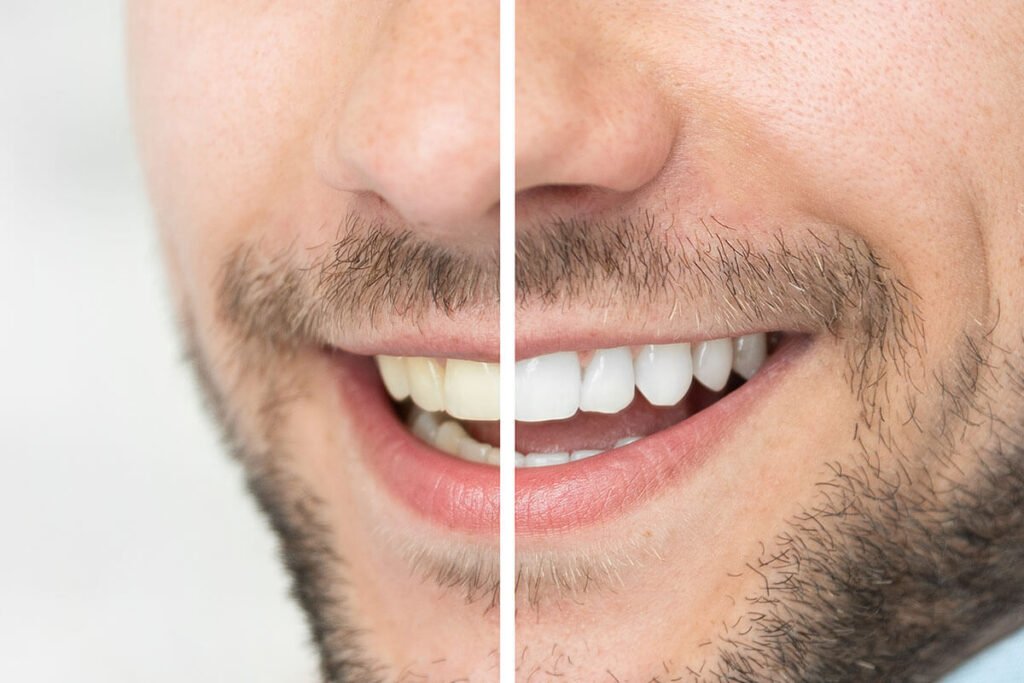A bright, white smile is often seen as a symbol of beauty and confidence, and many people turn to teeth whitening treatments to achieve it. However, while whitening can offer impressive results, it’s important to understand the process, its benefits, and potential risks before deciding to brighten your smile. Here’s what you need to know about teeth whitening.
How Teeth Whitening Works
Teeth whitening works by using a bleaching agent, typically hydrogen peroxide or carbamide peroxide, to break down stains on the enamel of your teeth. These agents penetrate the enamel and break up discoloration caused by factors such as coffee, tea, wine, smoking, and aging.
There are various whitening methods available, including over-the-counter products, professional treatments from a dentist, and natural remedies. Each has its own set of benefits and limitations.
Types of Teeth Whitening
- Professional Whitening (In-office treatment)
The most effective and quickest way to whiten teeth is through a professional treatment at your dentist’s office. Dentists use stronger whitening agents than those found in over-the-counter products, which can lead to faster, more dramatic results. Professional whitening is typically done in a single visit, and the procedure can be customized to suit your needs. While it’s more expensive than at-home options, it offers the safest and most effective results. - At-home Whitening Kits (Custom or over-the-counter)
At-home whitening kits, which can be purchased over the counter or through your dentist, often contain a lower concentration of whitening agents. These kits come in the form of strips, trays, gels, or pens and require you to follow the instructions carefully. While less expensive than professional treatments, at-home kits generally take longer to show results and may not provide the same level of whitening. - Natural Remedies
Some people opt for natural teeth whitening solutions, such as baking soda, activated charcoal, or coconut oil pulling. While these methods are often more affordable, they may not be as effective in whitening teeth, and some can be abrasive or cause other oral health issues if used improperly. It’s essential to consult your dentist before trying any natural remedies.
Pros of Teeth Whitening
- Enhanced Appearance: Teeth whitening can make your smile appear younger and more vibrant, boosting your overall appearance and confidence.
- Quick Results: Professional treatments can deliver visible results in just one visit, while at-home treatments gradually brighten your teeth over a few days or weeks.
- Non-invasive: Whitening treatments are generally painless and do not involve any surgical procedures.
- Safe when done correctly: Under the guidance of a professional or when using approved at-home products, whitening is generally considered safe for most people.
Potential Risks and Side Effects
While teeth whitening can offer a brighter smile, it does come with potential side effects. Here’s what you should consider before undergoing any whitening procedure:
- Tooth Sensitivity
One of the most common side effects of teeth whitening is increased tooth sensitivity. The bleaching agents can temporarily irritate the nerves of the teeth, causing discomfort when consuming hot, cold, or sweet foods and beverages. This sensitivity usually fades after the treatment ends, but it can be bothersome during the process. - Gum Irritation
The whitening agents can cause irritation to the gums if they come into contact with them. Professional treatments typically use protective barriers to prevent gum exposure, but at-home treatments may not provide the same level of protection. - Uneven Results
Whitening may not be as effective on certain types of stains, such as those caused by medications or trauma. Additionally, teeth with dental work, like crowns, veneers, or fillings, may not whiten the same way as natural teeth, leading to uneven results. - Overuse and Damage
Overusing whitening products, especially at-home kits, can lead to damage to your tooth enamel, making your teeth more prone to decay and sensitivity. It’s essential to follow the instructions and avoid excessive use of whitening products.
How to Maintain Your Results
After whitening your teeth, maintaining your bright smile requires some effort:
- Avoid Staining Foods and Drinks: Limit your intake of foods and beverages like coffee, tea, red wine, and berries that can stain your teeth. If you do consume these items, rinse your mouth with water afterward to help reduce staining.
- Practice Good Oral Hygiene: Brushing your teeth twice a day, flossing, and using mouthwash will help keep your teeth clean and reduce the buildup of plaque, which can lead to stains.
- Touch-up Treatments: Depending on your whitening method, you may need periodic touch-up treatments to maintain your results. This can be done with over-the-counter products or through your dentist.
Conclusion
Teeth whitening can provide noticeable results and help improve the appearance of your smile. However, it’s essential to understand the different methods available, the potential risks, and how to care for your teeth after the procedure. Consulting with your dentist before starting any whitening treatment is always a good idea to ensure the process is safe and effective for your unique needs.
References
- American Dental Association (ADA). (2021). Teeth Whitening: Is It Safe?. Retrieved from https://www.ada.org
- Mayo Clinic. (2021). Teeth Whitening: What You Should Know. Retrieved from https://www.mayoclinic.org
- WebMD. (2020). How Teeth Whitening Works and What to Expect. Retrieved from https://www.webmd.com
4o mini

